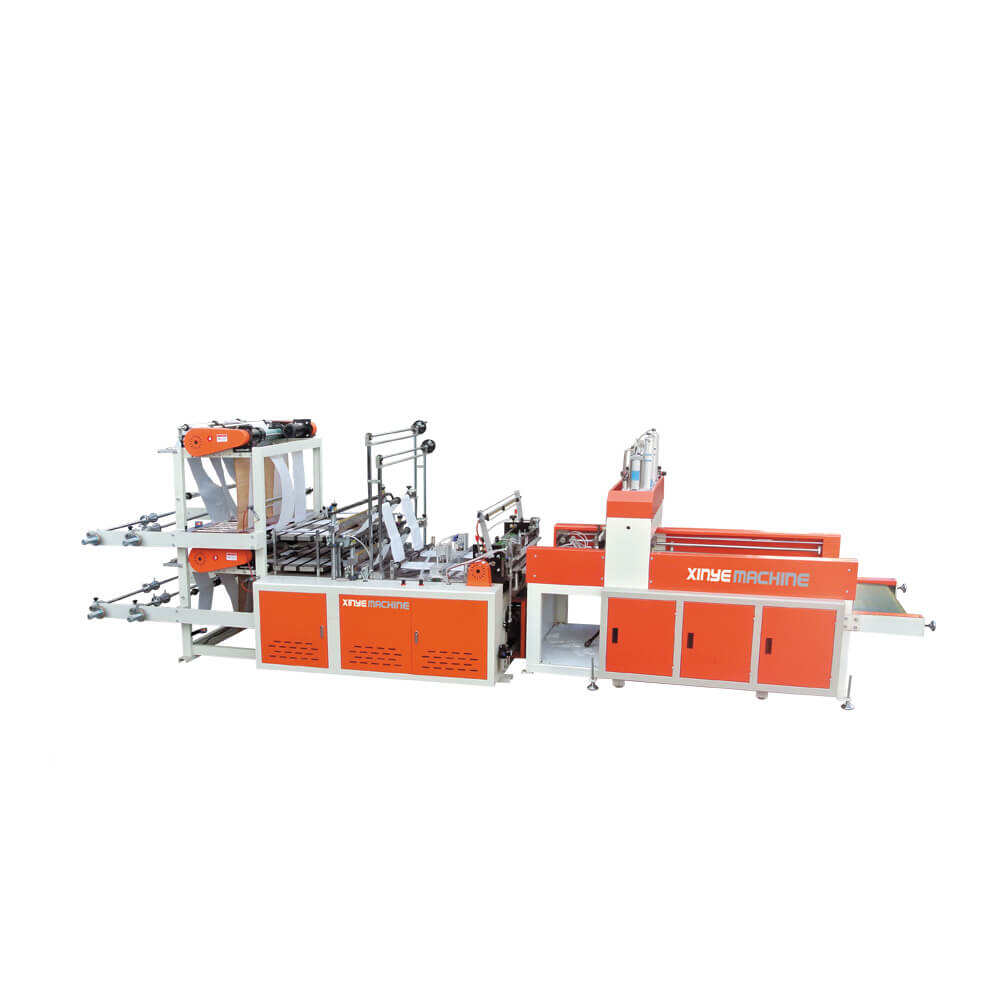Understanding the Core Stages of Shopping Bag Manufacturing
From raw materials to finished product: Overview of the shopping bag production workflow
Shopping bag production turns raw plastics or paper pulp into those bags we see on store shelves through several key steps. First comes the material prep stage, which actually takes up around a third to two fifths of the whole manufacturing timeline. During this phase, manufacturers mix resins or work with pulp blends until they get just the right balance of strength and flexibility needed for everyday use. After that, specialized extrusion machines kick in, heating everything up to scorching 220 degrees Celsius (which is about 428 Fahrenheit) to shape the basic materials into what will eventually become either plastic films or paper substrates for our shopping needs.
Extrusion and blown film technology for film-based shopping bags
Advanced blown film extrusion lines produce polyethylene films between 18–30µm thick at speeds exceeding 120 meters per minute. Twin-screw extruders with automated die gap control maintain ±2% thickness consistency, while multi-layer co-extrusion enables barrier properties–achieving up to 95% moisture resistance for food-grade applications.
Cutting, sealing, and automated bag formation in high-speed lines
Integrated servo systems synchronize ultrasonic cutting with precision of ±0.5mm and heat sealing cycles as fast as 0.25 seconds, enabling output rates of 400–600 bags per minute. Vision-guided robotics ensure 99.8% accuracy in handle attachment, reducing material waste by 22% compared to manual methods.
Precision converting operations for consistent, high-volume output
Automated winders and slitting machines convert 2.5-meter master rolls into retail-sized reels with a tight 0.1mm diameter tolerance. Laser micrometers provide real-time thickness monitoring, rejecting only 15 defective units per million, ensuring batch consistency across runs exceeding 500,000 units and compliance with ISO 12647-2 standards.
Integrating Automation to Enhance Shopping Bag Production Efficiency
Role of automation in modern shopping bag manufacturing lines
Automation enables near-continuous 24/7 operation with error rates below 1%, delivering 25% higher throughput than manual setups. AI-driven predictive maintenance reduces unplanned downtime by 40%, while real-time sensor networks adjust film thickness within ±0.02mm, maintaining uniformity across 98.7% of output.
Synchronizing machinery functions through seamless system integration
Centralized PLC controllers align extrusion rates with downstream processes across 12-stage production lines, maintaining synchronization within ±0.5 seconds. This precision prevents recurring issues like material jams, saving an average of $18,000 monthly in corrective interventions. IoT-enabled dashboards improve cross-functional coordination, cutting interdepartmental delays by 55%.
Advanced automated cutting and handling systems for higher throughput
High-speed laser cutters operate at 3.2 meters per second with 0.1mm precision, supported by vacuum-assisted feeding systems handling 150 bags per minute. These systems reduce production costs by $0.007 per bag while achieving 99.4% dimensional accuracy–essential for meeting strict retail packaging specifications.
Ensuring Durability and Consistency Through Quality Control Systems
Heat sealing techniques and seam strength testing for long-lasting bags
With precision heat sealing, temperatures stay pretty much right around ±2°C when bonding those polymer layers together, so nothing gets degraded in the process. The infrared sensors check each seal's integrity as they go through more than 120 bags every minute. And don't forget about the peel strength tests either. These show we're hitting at least 18 Newtons per square centimeter, which actually beats what the ISO 13934-2 standard requires for textiles. When dealing with biodegradable stuff though, things work differently. Ultrasonic sealing comes into play here, using those high frequency vibrations rather than straight up heat. This approach keeps the material's structure intact, something regular heat would mess with.
Industrial stitching, handle reinforcement, and stress point optimization
The automated bar tacking process adds between 8 to 12 layers of stitching right where handles attach, which can hold up under dynamic loads exceeding 40 pounds. With computer controlled needle positioning, we get about 0.2mm precision on those stitches. And when it comes to testing how durable these attachments are, our accelerated wear tests can simulate what happens after six months of regular use in just three days flat. We also use finite element modeling techniques to find the best spots for extra reinforcement. This approach has cut down handle failures in real world conditions by roughly one third according to our field tests last year.
Multi-stage quality inspection to minimize defects and ensure compliance
The vision inspection systems we use come with 5MP cameras that run through 23 different points on each bag while moving at around 150 units per minute. These systems can spot defects as tiny as 0.3mm, which is pretty impressive for something happening so fast. We also have people doing regular manual checks to make sure everything lines up properly both on the gussets and the printed areas when compared to our digital models. For tracking quality over time, we rely on SPC dashboards that show us where problems tend to pop up during different shifts. When these trends start showing up, operators can jump in right away to fix whatever might be causing issues. Our goal is to keep rejections under 0.8% most days, which meets those strict EU standards for packaging materials.
Designing Efficient and Scalable Production Line Layouts
Optimizing Material Flow and Spatial Layout for Maximum Efficiency
U-shaped production layouts reduce material handling distances by 30–40% compared to linear arrangements, enhancing workflow efficiency. Leading manufacturers apply three key strategies:
- Vertical Integration – Stacking extrusion units above printing stations saves floor space
- Sequential Workstations – Placing heat-sealing machines within 8 meters of cutting modules minimizes transfer delays
- Buffer Zones – Temporary storage carousels between bag formers and packers absorb output fluctuations
An industrial engineering study from 2022 found these optimizations reduce non-productive operator movement by 58 seconds per cycle.
Space-Saving Configurations for Compact Factory Environments
Full shopping bag production lines now fit within 1,200 m² using compact design solutions such as dual-layer conveyors with vertical lifts, collapsible palletizers requiring just 2.7m² when retracted, and integrated utility corridors positioned above equipment.
Modular Line Design for Flexibility and Future Scalability
Bolt-on expansion modules allow top-tier manufacturers to increase capacity by 35% without relocating core machinery. Standardized interfaces support rapid upgrades:
| Upgrade Type | Installation Time | Capacity Gain |
|---|---|---|
| Additional printing units | 6–8 hours | 22% |
| Auto-packaging arms | 4 hours | 17% |
Balancing Production Capacity with Operational Footprint
Using advanced simulation tools, manufacturers achieve 91–94% space utilization while preserving ISO-compliant safety pathways. Modern compact layouts sustain outputs of 18,000 bags per hour with less than 3% downtime, demonstrating scalability without spatial compromise.
Maximizing ROI: Cost Management, Maintenance, and Real-World Application
Strategies for reducing operational costs and improving production efficiency
Energy monitoring and predictive maintenance can lower annual operating costs by 12–18%. IoT-enabled systems detect inefficiencies in extrusion and optimize resin usage. Automated resource allocation has been shown to improve ROI by 22% in high-volume polyethylene bag production.
Preventive maintenance practices for continuous, reliable operation
Scheduled lubrication and component replacement prevent 85% of unexpected stoppages in sealing systems. Predictive tools like vibration analysis and thermal imaging identify motor misalignment early, avoiding disruptions in blown film extrusion. These systems reduce downtime-related costs by $74 per hour in continuous operations.
Overcoming common challenges in shopping bag production line design
Variations in material thickness can lead to 15–20% waste during handle reinforcement if not properly managed. Modular machine designs enable quick changeovers between recycled and virgin polymers–cutting transition time from 8 hours to 45 minutes. Advanced tension control ensures stable web handling even at speeds above 200 bags per minute.
Case study: Integrated line implementation by a leading packaging manufacturer
A recent integration of 32 synchronized machines achieved an 18% reduction in production costs through automated quality checks and closed-loop recycling. The system produces 12,000 laminated bags per hour with 99.3% dimensional accuracy. Unified controls improved energy efficiency, yielding a 40% better energy-to-output ratio across compression molding and ultrasonic sealing stages.
FAQ Section
What are the main materials used in shopping bag production?
The primary materials used in shopping bag production include plastics such as polyethylene and paper pulp blends. These are prepared during the initial stages to achieve a balance of strength and flexibility.
How do quality control systems ensure the durability of shopping bags?
Quality control systems utilize techniques such as precision heat sealing, infrared sensors, and peel strength tests to ensure the integrity and durability of shopping bags. They also employ accelerated wear tests and finite element modeling for reinforcement.
What role does automation play in shopping bag production?
Automation plays a crucial role by enabling 24/7 operation, reducing error rates, increasing throughput, predictive maintenance, and real-time adjustments to maintain uniformity, ultimately enhancing efficiency and reducing downtime.
How can production line layouts affect manufacturing efficiency?
Efficient production line layouts can significantly reduce material handling distances, minimize non-productive movements, and optimize workflow through strategies like vertical integration, sequential workstations, and buffer zones.
How is production scalability achieved in shopping bag manufacturing?
Scalability is achieved through modular line designs that allow manufacturers to expand capacity without relocating machinery, ensuring high space utilization while maintaining throughput and minimizing downtime.
Table of Contents
- Understanding the Core Stages of Shopping Bag Manufacturing
- Integrating Automation to Enhance Shopping Bag Production Efficiency
- Ensuring Durability and Consistency Through Quality Control Systems
- Designing Efficient and Scalable Production Line Layouts
- Maximizing ROI: Cost Management, Maintenance, and Real-World Application
-
FAQ Section
- What are the main materials used in shopping bag production?
- How do quality control systems ensure the durability of shopping bags?
- What role does automation play in shopping bag production?
- How can production line layouts affect manufacturing efficiency?
- How is production scalability achieved in shopping bag manufacturing?




